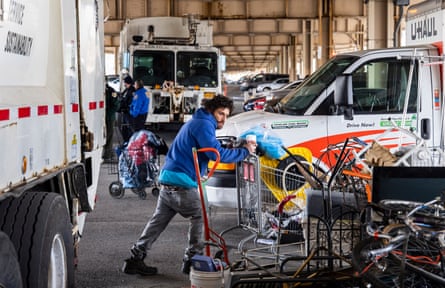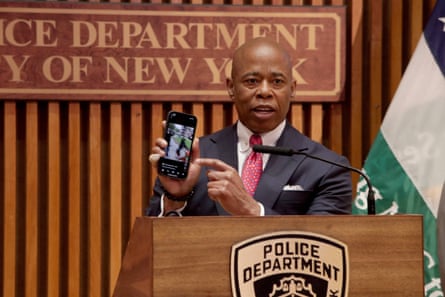The sidewalk was dotted with white party tents, music streamed through DJ Jay Five’s speakers, kids danced and men in Safe Summer shirts flipped burgers on a charcoal grill.
The block party on 54th Street in Queens’ Woodside neighborhood was leading up to a long-awaited reveal. A few feet away, a red ribbon covered the door to the new violence intervention site – a center to advance community-driven public safety, through healing, conflict mediation and training.
“This is about us investing in us,” K Bain, the founder of Community Capacity Development, the organization behind the venture, told the crowd. “When we begin to invest in us, they will have to take notice when we take back our communities.”
Watching as Bain cut the ribbon were the people that New York City’s mayor, Eric Adams, has often called the “ecosystem of public safety”: police officers from the 114th precinct, violence intervention workers, elected officials, and service providers from other community-based organizations.
All were filled with a sense of urgency.
The summer months are historically the most violent, and New York City is facing a surge in gun crime, largely coinciding with the pandemic. In particular, the murder of two police officers in February, and a mass shooting on a Brooklyn subway train in April – though not emblematic of the community violence that makes up the majority of shootings – shocked New Yorkers and put pressure on their new mayor, who campaigned on public safety.
The steps he has taken so far, however, have left some concerned that New York hasn’t learned from its past battles with violent crime. Even with the city far safer than it was in the 1990s and early 2000s, critics say the mayor is falling back on old so-called “tough-on-crime” strategies while neglecting other strategies that worked in the 2010s to give the city its second historic drop in crime.
During his campaign, Adams received frequent national news coverage as a foil to the Defund the Police movement, but he also promised he would pursue a balanced approach, combining more policing with enhanced social services and investments in community-based initiatives.
Five months into his term, Adams has moved fast. There’s a new initiative to crack down on low-level crimes like subway fare beating, open container (drinking in public) and dice games, which the police claim lead to violence. He has prioritized cooperation with federal law enforcement to intercept gun trafficking. And he is removing homeless people from encampments, arguing that they would be safer in shelters – and the city would be safer if they were not living on the streets.

Then there’s perhaps the most controversial component of Adams’ gun violence strategy: Neighborhood Safety Teams, a revamped version of a plainclothes anti-crime unit that was disbanded in 2020 amid the George Floyd protests. The unit was responsible for a disproportionate number of police shootings and abuse complaints. The new version, unlike past iterations, will wear a uniform with clear police identification, but will still use unmarked cars.
The units have made gun arrests, but data obtained by the City & State New York found that their most common arrests were for low-level offenses: in its first three weeks, the anti-gun units picked up more people for possession of a fake ID or stolen credit card than for possession of a firearm.
“It does sound very similar to the ‘broken windows’ model,” says public advocate Jumanne Williams, referring to the controversial strategy – employed under former Mayor Rudy Giuliani and police commissioner Bill Bratton in the 1990s – that suggests low-level enforcement prevents more serious violence. The strategy disproportionately targeted Black and brown New Yorkers. “Everybody wants quality of life and wants quality of life issues to be dealt with. The question is: does it have to be the police that are doing it? And does it have to be [police] who we are sending first?”
The NYPD shifted away from broken windows-style policing amid Black Lives Matter protests after the death of Eric Garner, who was choked to death by police after being targeted for selling loose cigarettes in 2014. His death was a stark intersection between broken windows policing and anti-crime units – two central components of Adams’ plan.
Advocates of broken windows and stop-and-frisk, another style of aggressive policing used under Mayor Michael Bloomberg that was ruled unconstitutional in 2013, credited those styles of policing for the crime decline of the 1990s and 2000s. Shifting to a lighter touch, they warned, would lead to more violence.
Instead, as arrests went down, so did shootings. The period from 2015 to 2019 marked a second great crime decline in New York City – notably, at a time when violence was stable or increasing elsewhere.
“At that point, New York City looked more like Scandinavian countries” in both its incarceration rates and its levels of gun violence, said Elizabeth Glazer, the former director of the Mayor’s Office of Criminal Justice. “New York City had the lowest crime rates on record in its history.”
The mayor at the time, Bill de Blasio, made historic investments to coordinate and expand existing networks of non-profits working to reduce violence through intervention and prevention. His administration built out the Crisis Management System, the city-coordinated network of anti-violence groups, and NeighborhoodStat, a program that allowed public housing residents to set priorities around quality-of-life issues and hold city agencies accountable for delivering.
Meanwhile, judges and prosecutors began to pursue alternatives to incarceration, such as diversion. The city council gave police officers more discretion to issue civil rather than criminal summons for low-level crimes, and the New York legislature required officers to release certain people with written orders to appear in court, known as desk appearance tickets, instead of booking them into jail.
“The foot really came off the gas on arrests. At the same time, there was a very concerted effort to build up the neighborhood organizations and approaches to crime,” Glazer said.
The number of police officers didn’t decline. Neither did funding. New York retained the largest and most well-funded police force in the world. It just spent its energy on different things.
And the decline in shootings continued.
Then, in 2020, the pandemic struck. By the summer, gun violence began to rise, and by the end of the year the number of shootings had nearly doubled. The surge most heavily affected Black and brown communities.
“In those neighborhoods that have already been high needs, when you take away resources, when you take away access to food, when kids can’t go to school, when you put all those things together, it really creates this recipe for community violence,” said Hailey Nolasco, the director of community-based violence prevention at the Center for Court Innovation.
New York is still far below historic highs. Its rate of shootings is similar to the 2006-2011 period, when Michael Bloomberg was mayor.
For those affected, however, the crime uptick is very real – leading many New Yorkers to look back at the first great crime decline of the 1990s and what they believe, rightly or wrongly, led to that decline, while ignoring the second great crime decline – the one that was unique to New York and relied on methods other than law enforcement.
“We have sort of forgotten everything. And so we now are defaulting back to what we did in the 90s, which is send in the police,” Glazer said.

Indeed, Adams has proposed increasing the NYPD’s operating budget by more than $180m, to $5.6bn. (The NYPD’s total budget is more than $11bn counting pensions, debt service and fringe benefits.) Much of the increase will go to paying for more overtime and for the revamped anti-gun teams.
Even some of Adams’ supporters say the city shouldn’t be relying on police as a panacea.
“The city’s pumping all this money into more policing, but as we see, it’s not working,” said Queens borough president Donovan, who was an important endorser of Adams’ campaign in 2021, at the ribbon cutting in Queens. “You have to get to the root causes. You have to invest in real solutions.”
Some observers do believe Adams understands this, and gets the multidisciplinary approach to violence. “People don’t acknowledge the holistic approach that we are doing to stop crime,” Adams said in March. His Blueprint to End Gun Violence includes plans to place a gun violence prevention liaison in every city agency, from sanitation to parks, to foster a “whole-of-government” approach to the crisis.
Adams has also acknowledged gun violence as a public health issue, and he has increased funding for the city’s summer youth employment program, which will offer 90,000 summer jobs for young people ages 14 to 24, up from 75,000 last year.
After his preliminary budget proposing nearly across-the-board cuts for hospitals, education, and housing attracted criticism from the city council, he responded with an additional $55m to deploy mental health workers on the streets and more than $171m for 1,400 shelter beds. The modest shift drew some praise from progressives, including Williams. Still, the education and social services departments will see their overall budgets decline.
As for the Crisis Management System – the network of city-funded anti-violence organizations that worked so well under De Blasio – Adams promised during his campaign to expand it. Despite his rhetoric, however, there hasn’t yet been an increase in funding. Just the opposite: city budget analyses show that funding for CMS will decline from $135m to $99m in the fiscal year beginning 1 September 2022.
Meanwhile, the system faces its ownchallenges, many of which existed long before Adams took office. Unlike the police, most anti-violence non-profits cannot pay overtime, much less offer 24-hour service, and typically need to front their own cash before they can be reimbursed by the city.
“It’s an antiquated system that has not necessarily served Black and brown organizations in the past,” said Nolasco.
A properly funded CMS would help it fulfill its full potential, she said – and Adams has not yet provided details about how he would do that.
“If we saw these trends of violence going down while we’ve been bolstering community-led efforts,” Nolasco said, “let’s continue to bolster community-led efforts and not cause more harm to our communities that we are going to end up apologizing for later.”
“The police and prosecutions and jail and prison, actually, do make a difference,” Glazer said. “But we’ve also learned about the harms. And maybe even more importantly, we’ve learned about so many other ways that we have of creating safety.”
